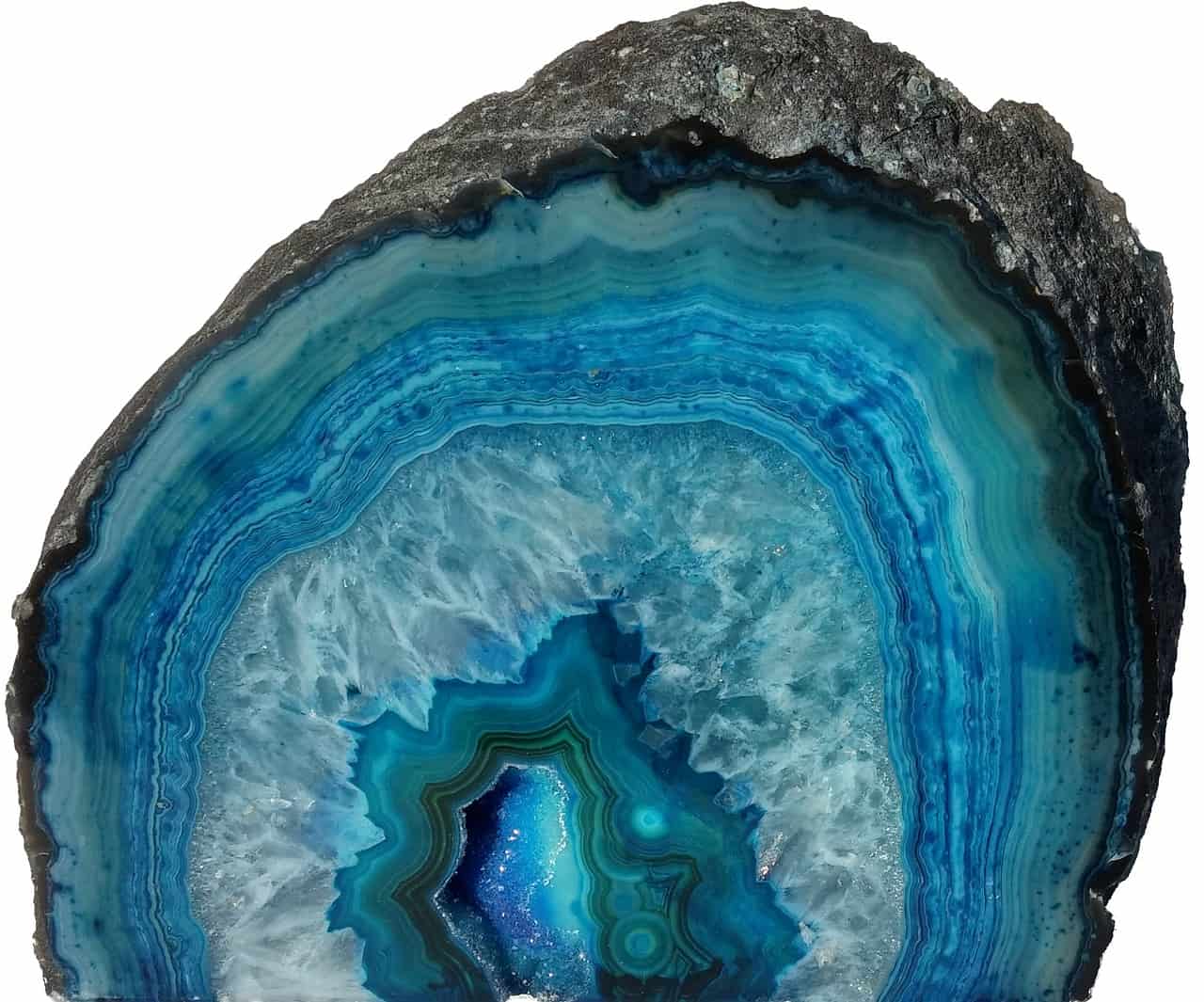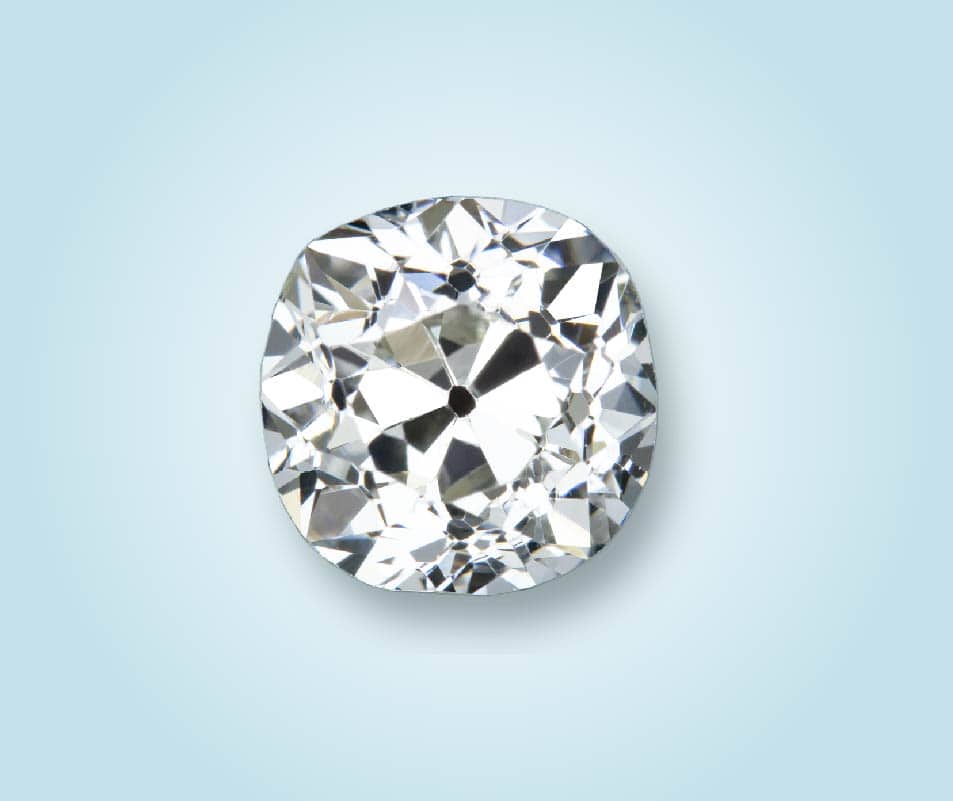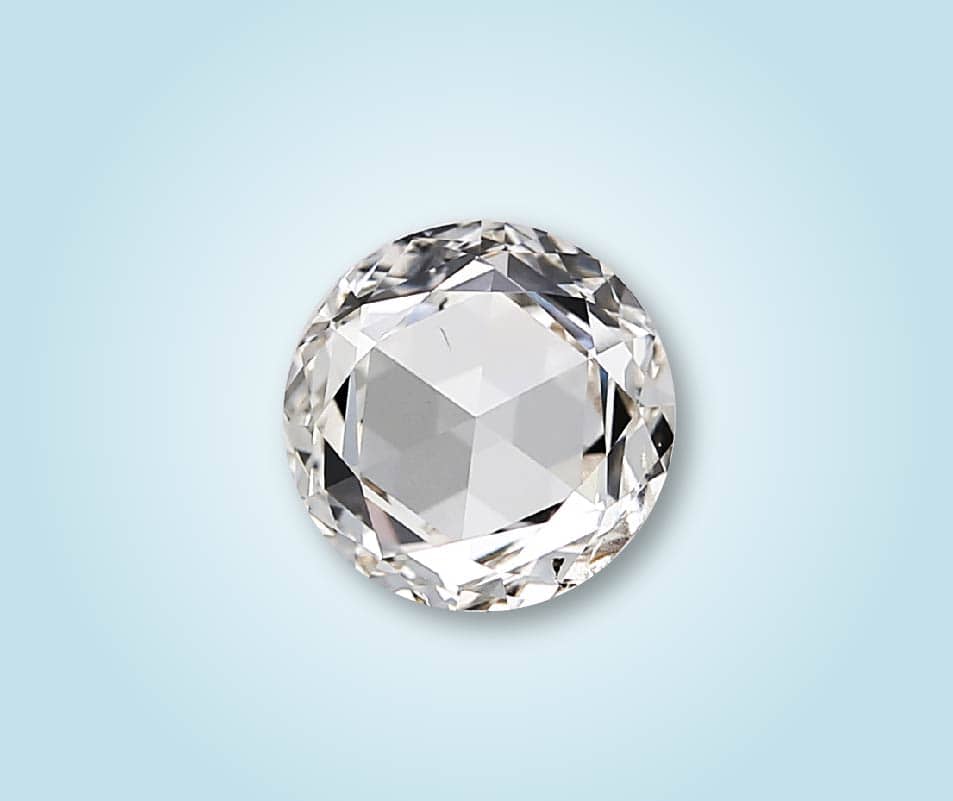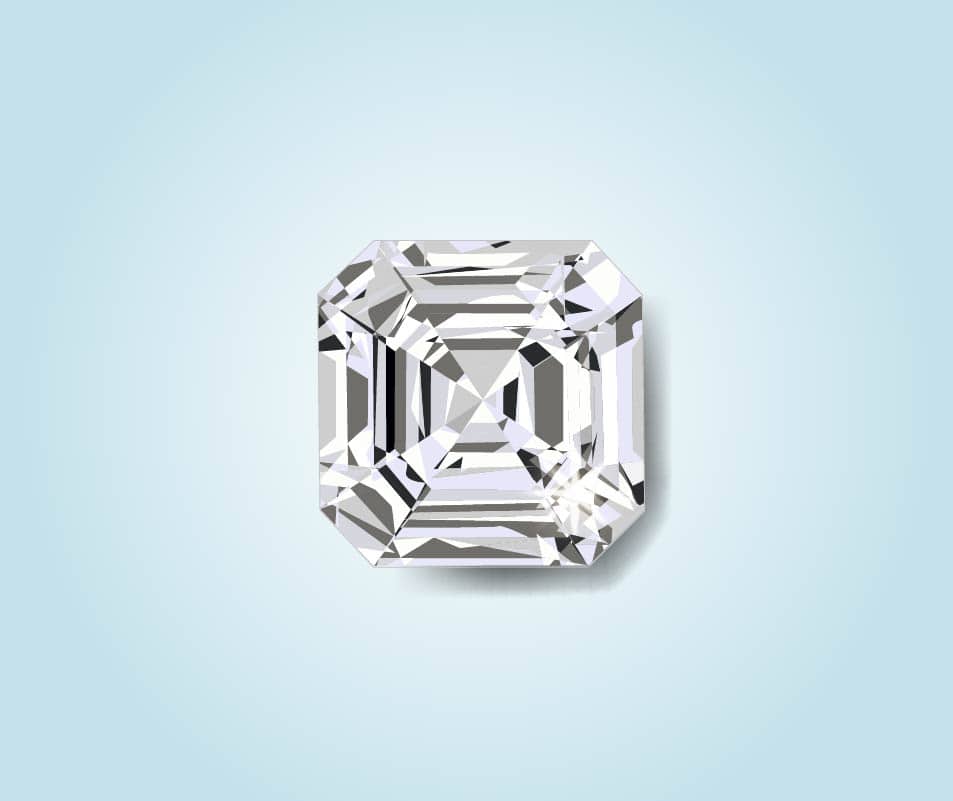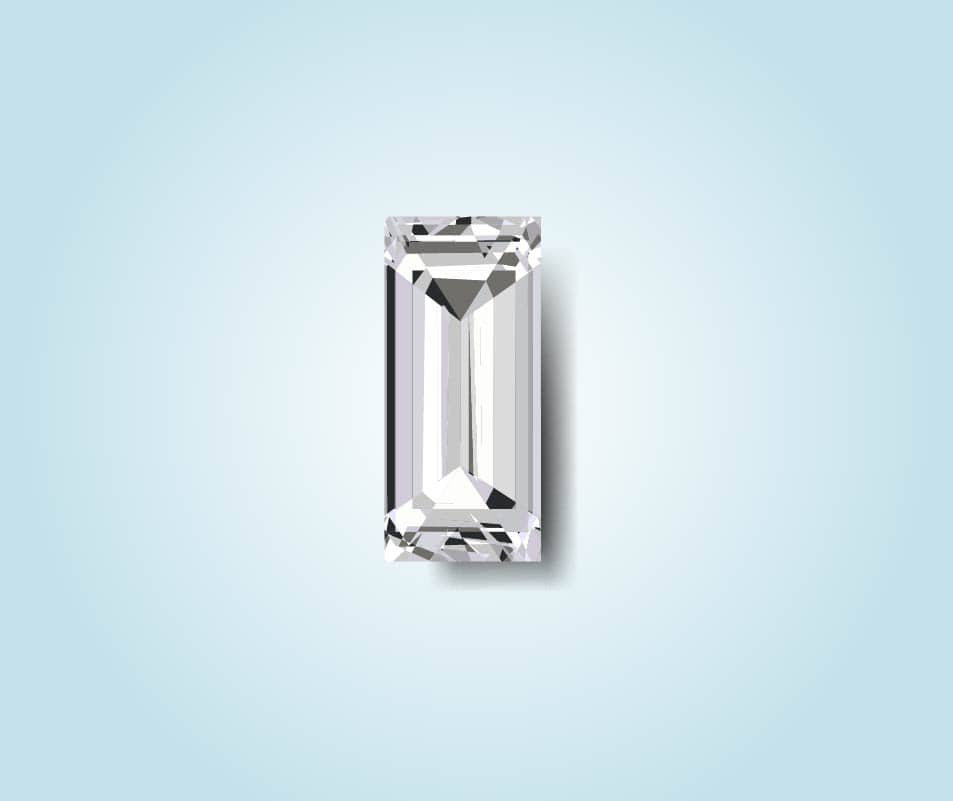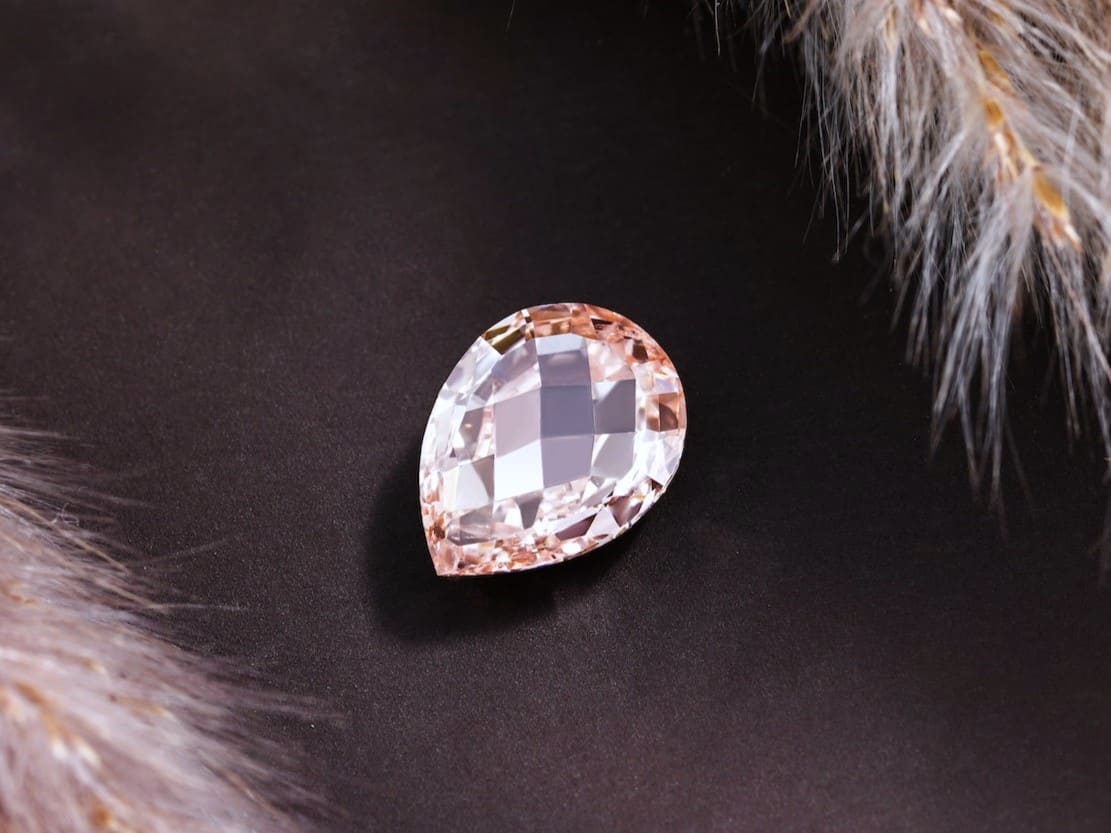Looking for an in-depth comparison between moissanite and cubic zirconia?
Perfect, you're in the right place!
In this expert Learning Jewelry guide, you'll learn:
- How does a moissanite compare to a cubic zirconia?
- What're the differences in appearance between moissanite and cubic zirconia?
- How do the prices compare between moissanite and cubic zirconia?
- And much more!

Moissanite and cubic zirconia are probably the most popular diamond alternatives out on the market. But just because they look like diamonds, doesn’t mean that they are diamonds.
Both moissanite and cubic zirconia have different chemical and physical properties compated to a diamond and also compared to each other. Let’s take these two popular diamond look-a-likes and pit them against each other to find out which is the superior stone.
Moissanite Vs Cubic Zirconia: Origin
Moissanite and cubic zirconia are both alternatives to diamonds, and they are both lab-created in the jewelry market.
Moissanite
A lot of people will refer to moissanite as a fake diamond, but that’s not the whole story. Moissanite is actually its own gemstone. A French scientist named Henri Moissan was digging in Arizona. He uncovered a glittering gemstone that he thought to be diamond.

Turns out, it was an entirely different stone, now called moissanite. Natural moissanite is actually thought to be from meteorites, which is how the stone earned the names of “Space Diamond” or “Stardust.” But it’s so rare, don’t expect to find it any jewelry store, online or brick and mortar. Jewelry stores that sell moissanite engagement rings and wedding bands are using lab created moissanite.
Charles & Colvard were the world’s first company to synthesize the disco ball gemstone, and then other companies followed. Each lab creates moissanite stones a little differently in terms of style, but the same basic process.
Charles & Colvard carries the most famous moissanite of all, the Forever One Moissanite. This is the highest quality moissanite in the jewelry industry. It takes about 2-3 months to create one singul ar moissanite gemstone. It took quite a few years for gemologists to get it right.
To create a moissanite stone, scientists mix silicon and carbon under extremely hot pressure. This creates silicon crystals, aka preforms. The preform are shipped off to be cut to the most sparkly of standards.
Read also: Moissanite vs Lab Diamonds
The Forever One Moissanite has higher standards than the average moissanite. Its base is still made with silicon carbide, but the way they structure it is different than most moissanite stones. When they stack it that way, the stone has much better color.
While most people that buy moissanite want colorless moissanite, the gemstone also comes in every color of the rainbow. Charles & Colvard also have a gorgeous line of colored moissanite.
Cubic Zirconia
Cubic zirconia earrings are popular and have a number of names. You may hear it referred to as a fake diamond, diamond simulant, or man-made diamonds. Diamond simulant would be a proper term.
Like moissanite, cubic zirconia in its natural form is very rare. So, they synthesized it by taking powdered zirconium oxide and melting it with calcium and magnesium. The elements are melted, mixed and fused together, then are left to cool.

Once the mixture cools, the crystals begin to form. The crystals are then faceted into gem quality stones. And like moissanite, different labs produce cubic zirconia differently. The process can be boiled down to 1 of 3 methods: melting process, growth solution, and high pressure high temperature.
Read also: Cubic zirconia vs lab-grown diamonds
Also like moissanite, CZ comes in every color you can think of. It can be created in any hue. Cubic zirconia is mainly used in costume and body jewelry. Many high end retail jewelry stores like Jared, BC Clark, and Zales may not carry many or any cubic zirconia in store. You should find cubic zirconia either online or in department store jewelry such as Ross, Walmart, or Kohl's.
Moissanite Vs Cubic Zirconia: Appearance
A lot of people might say that moissanite and diamonds looks the same, but their optical properties are quite different as well.
To the untrained eye, it might not seem that way, so we'll walk you through the difference in appearances with moissanite and lab created diamonds. Moissanite has almost twice the brilliance of a diamond. It will appear more sparkly, with tons of rainbow light.
When set side by side next to a diamond, it'll be obvious to tell which is the moissanite because it'll be the stone that glitters like a disco ball!
Cubic zirconia also has lots of rainbow light in its sparkle, but not as much as moissanite. Moissanite has a higher refractive index than cubic zirconia. The refractive index tells us the measurement of how fast light is bent when it goes into the gemstone and bends out. Moissanite measures around 2.65. Cubic zirconia's refractive index is 2.15. This means that moissanite has more rainbow light.

Both these gemstones have double refraction, also known as birefringence. This is when a ray of light going into the stone bends and splits into two rays. Those two rays are reflected out of the diamond in different directions.
Cubic zirconia stones may appear glassy, while moissanite will have excellent light dispersion, also referred to as fire. A moissanite's fire is even 2x higher than a real diamond.
Read also: Fake diamond earrings that look real
If you're wanting either of these gems to tone down their sparkle a little bit, you should consider the gem shape. Look for step-cut shapes, not brilliant shapes. Common brilliant cut shapes include round brilliant, princess cut, oval, radiant, and pear cuts.
Brilliant cut shapes have short facets that cause a stone to glitter. Step cut shapes like emerald cut, Asscher cut, and baguettes. The facets are longer, giving off more of a dramatic flash than a full on glitter performance.
You should also know that even though these stones are colorless, moissanite isn't entirely colorless. In some lighting, it's been known to have a grayish or light brown tint. It's subtle, but still there. In higher quality moissanites, this tint isn't as noticeable. Cubic zirconia stones can be completely colorless, equivalent to the diamond color grade "D."
Moissanite Vs Cubic Zirconia: Price
When it comes to price comparison between a moissanite ring and a CZ ring, there's a big difference. On average, most people purchase a 1 carat diamond for an engagement ring. For an eye-clean diamond ring, a high quality one may cost around $5,000.
But with moissanite and cubic zirconia, a 1 carat is pretty small and cheap. Both cubic zirconias and moissanites are usually sold in larger carat weights without much of a price difference.
This 2-carat moissanite ring is from the Forever One Moissanite collection and costs $2,000 at Helzberg Diamonds. Forever One Moissanites are the best quality moissanite rings that money can buy.

Moissanite quality doesn't go by the 4cs like diamonds, but is distinguished by simple terms. All Forever One Moissanites are Super Premium quality. Charles & Colvard also sells Premium quality moissanites, which cost a little less. Regular moissanites are the least expensive.
Super Premium moissanites have the diamond color grade equivalent to a DEF. Premiums are equal to GH, and regular moissanites can be HI. Lower quality will have more tint. Keep in mind that even DEF moissanites will have tints in some lighting. That's just how the stone is.
Cubic zirconia on the other hand doesn't have marketable quality. The stone in itself ranges from $5-$100, depending on other factors. Some places may create cubic zirconia differently than others, but there's not a set standard or quality assurance for these inexpensive stones.
Moissanite Vs Cubic Zirconia: Value
You can probably assume the value of the two gemstones based on their prices. Moissanite is a valuable stone as its own stone. Cubic zirconia is extremely cheap and holds no resale value.
Actually, in the jewelry industry, you'll find that jewelry doesn't keep its value usually unless it's a very old piece or heirloom quality.
Neither of these gemstones should be purchased for resale or investment purposes. With both of them being lab-created gemstones, scientists can readily develop more, so there's not a high demand.
Moissanite has more value because it's regarded as a semi-precious stone. Moissanites are the best alternative when it comes to durability and quality. Gemstones pretty much depreciate after being purchased, unless they come with a grading report. But moissanite is readily available, so you shouldn't see its price increased
Moissanite Vs Cubic Zirconia: Other Factors
Sometimes there might be other, less obvious reasons why someone might choose moissanite over a cubic zirconia, or vice versa. Let's check it out.
Durability
The biggest thing you want to think about when choosing an alternative stone is durability. One of the things we measure to test gemstone durability for normal wear is by using the Mohs scale of hardness. The hardness scale lets know if our stone is good enough to wear every day for years and years by measuring its scratch resistance.
Not all gemstones are made to wear as engagement rings or wedding bands. Some stones are very vulnerable to scratching. The Mohs scale rates from 1-10. Diamonds are rated at a 10, which means it's the hardest mineral in world. This goes for both natural diamonds and lab grown diamonds.
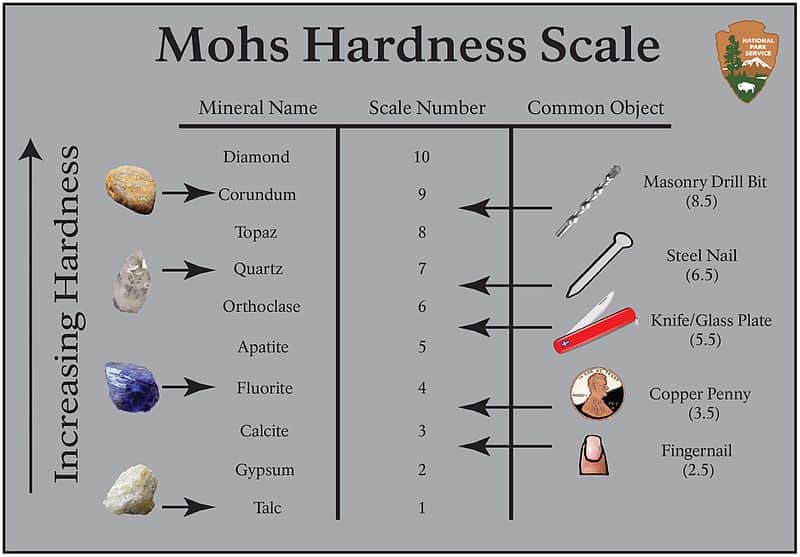
Image by the National Park Service. Public Domain.
Moissanite's hardness rating is a 9.25, making it the second best scratch resistant gemstone. It's even better than white sapphire, which rates at a 9. Moissanite is a perfect alternative diamond to choose that will last as long as a real diamond.
Cubic zirconia's hardness rating is 8-8.25. This is still relatively high in comparison to other diamond simulants like white topaz or clear quartz. It doesn't scratch too easily either, but wont' last near as long as a moissanite.
It should be noted that hardness doesn't determine the overall durability against chipping and breakage. Hardness just tests scratchability. Any lab created or natural gemstone can chip if hit it the right spot with a sharp blow.

But if you'd like to minimize that slim chances of that even happening, you might consider buying a ring that has a protective setting, like a bezel setting or flush setting.
Solitaire rings and other high set cathedral setting rings are the most prone to chipping because of how they stick out. Gem shapes with points like marquise or pear cut are more likely to chip as well.
Repairs
One of the biggest misconceptions in the jewelry industry is assuming a piece of jewelry's life expectancy directly relates to its quality. While it's true that more expensive materials can increase longevity, every material has its pitfalls. This is especially true with ring settings.
Chances are, you're purchasing an engagement ring that is set in some sort of metal: white gold, yellow gold, rose gold, platinum, or even sterling silver. This group of metals are called precious metals. Cheaper alternative metals include stainless steel, brass, tungsten, titanium, and others.

While alternative metals are cost effective, they're really hard to work on. Many of them can't be repaired if a center stone falls out. Stainless steel is hard to work on, so if you can find a jeweler that does, it'll be pretty expensive.
You should especially pay attention to your jewelry descriptions when buying jewelry on the internet. Many gold plated pieces are plated over stainless steel, so make sure you're buying the right size. So if you need a different size, you might not be able to find a jeweler that will resize it, or the cost will exceed its value.
You're more likely to come across this issue with cubic zirconia jewelry rather than moissanite. Cubic zirconia is most often set in gold plating and cheap metals. CZs have a reputation as an imitation diamond, so it's more likely to be found with imitation metals as well.
Read also: Which diamond dupe is the best?
You should take that into account when purchasing your jewelry. Gold is a soft metal, so it's going to need maintenance over the years. Gold plated jewelry needs to be replated too, but it might be harder and more expensive than its worth.
For this reason, you should consider buying a ring that has a warranty. Charles & Colvard moissanite engagement rings all come with their own warranty that covers them for life. You probably won't find cubic zirconia rings with warranties as it would be a loss for the seller.
Bottom Line: Moissanite Vs Cubic Zirconia
If you're stuck between these two gemstones and a hard place, allow us to help you sort out of your decision. Each of these stones has their ups and downs. First things first, you should think about why you're wanting to purchase this piece of jewelry and what you're wanting out of it.
For example, are you trying to buy some jewelry for a holiday party or event of some kind? Is this a piece you plan on wearing a lot, or is it something that's just going to be forgotten after being worn once? What's your budget? Do you have some cash to spend or is it dust bunnies in your wallet?
If you're just looking for some fashion jewelry to go with an outfit or to an event, you might want to go for cubic zirconia. They're cheap, look like diamonds from afar, and you can forget about it without feeling like you wasted money.
But if you're looking for high quality and something to last a lifetime, you should go for moissanite. If you want a different option than the usual diamond ring, a moissanite engagement ring is the best option for you.
If you're still not completely sold on the idea of a moissanite as a diamond alternative, you might consider checking out lab-grown diamonds, or synthetic diamonds.
Lab diamonds are real diamonds with different origin, but they have no resale value like mined diamonds. Their optical and physical properties are exactly the same, but they can be 30% to 50% cheaper than a mined diamond of the same diamond grades. Some are even cheaper.
If you're buying a CZ, we recommend you check out Amazon. If you're in the market for a moissanite ring, we recommend the Forever One Collection by Charles & Colvard from Helzberg Diamonds. And if you're wanting to check out lab-grown diamonds, we recommend our good friends at James Allen.





